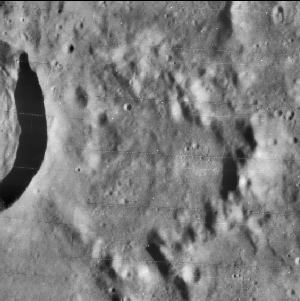Difference between revisions of "Tempel"
| Line 6: | Line 6: | ||
|} | |} | ||
<div id="toc"> | <div id="toc"> | ||
| − | [[Image: | + | [[Image:Tempel.t.jpg|external image jpg&height=300&width=300&bbox=10.8,2.8,13.0,5.0]]<br /> ''Lunar Orbiter IV'' (generated by USGS [http://www.mapaplanet.org/explorer/help/wmsUserDoc.html Web Map Service] from photographic mosaic) The strong shadow on the left comes from the similarly sized, but much fresher, crater [[Agrippa|Agrippa]]. The larger of the two relatively faint depressions just east of the point where the rims of the larger craters meet on the north is 6-km '''[[Agrippa|Agrippa]] F'''. None of the other features in this view are named.<br /> <br /> |
==Images== | ==Images== | ||
[http://www.lpod.org/coppermine/thumbnails.php?album=search&type=full&search=Tempel LPOD Photo Gallery] [http://www.lpi.usra.edu/resources/lunar_orbiter/bin/srch_nam.shtml?Tempel%7C0 Lunar Orbiter Images] [http://www.lpi.usra.edu/resources/apollo/search/feature/?feature=Tempel Apollo Images]<br /> - For orbital Apollo ''Fairchild'' camera photographs of '''Tempel''', see page [http://the-moon.us/wiki/Agrippa Agrippa], because '''Tempel''''s location is immediately eastward of '''Agrippa''' (touching '''Agrippa''''s eastern part).<span class="membersnap">- DannyCaes <small>Sep 25, 2010</small></span><br /> <br /> <br /> | [http://www.lpod.org/coppermine/thumbnails.php?album=search&type=full&search=Tempel LPOD Photo Gallery] [http://www.lpi.usra.edu/resources/lunar_orbiter/bin/srch_nam.shtml?Tempel%7C0 Lunar Orbiter Images] [http://www.lpi.usra.edu/resources/apollo/search/feature/?feature=Tempel Apollo Images]<br /> - For orbital Apollo ''Fairchild'' camera photographs of '''Tempel''', see page [http://the-moon.us/wiki/Agrippa Agrippa], because '''Tempel''''s location is immediately eastward of '''Agrippa''' (touching '''Agrippa''''s eastern part).<span class="membersnap">- DannyCaes <small>Sep 25, 2010</small></span><br /> <br /> <br /> | ||
Latest revision as of 20:01, 18 April 2018
Contents
Tempel
|
Lat: 3.9°N, Long: 11.9°E, Diam: 45 km, Depth: 1.25 km, Rükl: 34 |

Lunar Orbiter IV (generated by USGS Web Map Service from photographic mosaic) The strong shadow on the left comes from the similarly sized, but much fresher, crater Agrippa. The larger of the two relatively faint depressions just east of the point where the rims of the larger craters meet on the north is 6-km Agrippa F. None of the other features in this view are named.
Images
LPOD Photo Gallery Lunar Orbiter Images Apollo Images
- For orbital Apollo Fairchild camera photographs of Tempel, see page Agrippa, because Tempel's location is immediately eastward of Agrippa (touching Agrippa's eastern part).- DannyCaes Sep 25, 2010
Maps
(LAC zone 60D4) LAC map Geologic map LM map AIC map
Description
Description: Wikipedia
Additional Information
Depth data from Kurt Fisher database
- Westfall, 2000: 1.25 km
- Viscardy, 1985: 1.25 km
Nomenclature
- Named for Ernst Wilhelm Leberecht Tempel (December 4, 1821 - March 16, 1889), a German astronomer. He was a prolific discoverer of comets, discovering or co-discovering 21 in all, including Comet 55P/Tempel-Tuttle, now known to be the parent body of the Leonid meteor shower, and 9P/Tempel, the target of the NASA probe Deep Impact in 2005. Other periodic comets that bear his name include 10P/Tempel and 11P/Tempel-Swift-LINEAR.
- According to Whitaker (p. 226), this name was introduced by Krieger and König.
LPOD Articles
Bibliography